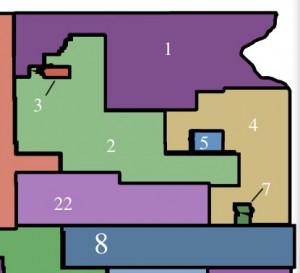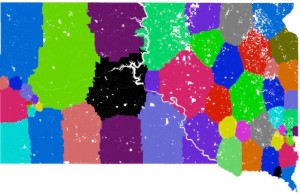The ballot measures keep coming—democracy rocks!
Attorney General Marty Jackley yesterday released the text of a proposed constitutional amendment to end gerrymandering. This initiated measure, sponsored by Doug Sombke on behalf of the South Dakota Farmers Union, would create an independent redistricting commission to draw South Dakota’s Legislative district boundaries.
The proposed amendment replaces Article 3 Section 5 of South Dakota’s constitution with the following provisions for forming the independent redistricting commission (IRC):

- The state Board of Elections picks nine South Dakotans to serve on the IRC.
- No more than three members of the commission can be members of the same political party. The intent appears to be to have three Republicans, three Democrats, and three Independents; however the text appears to leave open the possibility that the Board of Elections could select fewer main-party members and more Indies and/or minor party members.
- Each commission member must have maintained the same party registration status for at least three years prior to appointment to the IRC.
- No one who has been “appointed to, or elected to, any state public office or political party office” in the three years prior to appointment may serve on the IRC.
- No one who serves on the IRC may be “appointed to, or elected to, any state public office or political party office” for three years after appointment.
The amendment charges the independent redistricting commission with drawing “districts of equal population in a grid-like pattern across the state.” Of course, no square grid would fairly divide South Dakota’s people into balanced Legislative districts. Thus, the amendment proposes the following criteria for “adjustments” in district geometry:

- Follow state and federal law and court rulings (i.e., districts still must respect the Voting Rights Act and not dilute the voting power our Lakota neighbors and other minority groups).
- Keep population roughly equal.
- Make districts compact and contiguous.
- Draw boundaries that respect “communities of interest” (again, protect Indian voters, and more!).
- Draw boundaries along “visible geographic features, municipal and county boundaries, and undivided census tracts to the extent practicable.”
The amendment prohibits the consideration of any information about party registration and voting history from the redistricting process. The public and the Legislature get thirty days to comment on the IRC’s draft map, but the IRC alone draws the final map.
Under current law, the South Dakota Supreme Court steps in to draw the district map if the Legislature can’t pass a map. Under this amendment, failure is not an option: the amendment strikes the Supreme Court back-up plan and invests the IRC with sole authority over the map.
And for some real fun, if voters want to end gerrymandering, they don’t have to wait until the next Census. The amendment keeps decennial redistricting, just like under current practice, but it convenes the IRC to draw a new map in 2017, effective for the 2018 and 2020 elections, then redraws in 2021 to settle back to the post-Census groove.
South Dakota Democrats often cite redistricting as a tool they could use to get back some seats in the Legislature. Bob Mercer poo-poos that possibility, saying no map, independently drawn or otherwise, can make as much difference for Dems as restoring voter registration counts and “running candidates who are attractive, willing to work hard, can raise sufficient money and have politically acceptable ideas.”
In terms of politically acceptable ideas, the independent redistricting commission would make a good companion to Referred Law 19 and Referred Law 20 on the 2016 ballot. Referred Law 19 challenges the Legislature’s effort to protect incumbents from challengers on the ballot. Referred Law 20 challenges the Legislature’s effort to undermine ballot initiatives. The IRC amendment challenges the Legislature’s effort to choose their voters and make elections less competitive. Whether smart Democratic candidates can use these three issues to boost their electoral fortunes is an open question, but all three of these measures offer voters of all parties a chance to protect their rights and promote democracy.
Constitutional amendments require 27,741 signatures by November 9 of this year to make the 2016 ballot. That’s twice as many signatures as initiated and referred laws. Farmers Union, let’s get to work and end gerrymandering!
* * *
By the way, the Attorney General’s explanation of the IRC initiative is remarkably “objective, clear, and simple.” Rather than speculating about the cost of creating a new commission or trying to dig up some concern about court challenges (and you know his gerrymandering Republican friends want to talk about such things), AG Jackley simply summarizes the proposal and leaves it to voters to decide.
Outstanding news! The US Supreme Court recently upheld the Arizona independent districting commission. It’s long past time to take districting from the self-interested practices of the SD legislature. This measure will be the gate for a loyal opposition in the SD legislature: a minority with meaningful clout – clout to kraft better legislative solutions than emerge from single-party dogmatic rule. Certainly the SD legislature will remain republican, yet once adult-led redistricting occurs the more legislative races will be competitive and the better ideas and policies will rise.
Great job, Farmers Union!
A committee with real power and only 1/3 of the members are from the Republic Party? Why would the slopesided simpletons on the right be opposed to this “fair and balanced” approach to equality in elections? Because they’re BULLIES? Because they might not get their way? Let’s hear some valid objections, conservatives. Use your imagination …. oh, yeah. That’s not in your playbook, huh?
The CEO of Energy Transfers Partners is the official financial chairman of Rick Perry’s campaign for Potus while he is also the biggest donor to Perry’s Super Pac-which sounds like a clear violation of election laws prohibiting coordination between Super Pacs and campaigns. If Perry gets away with it,Cory,you should be in the clear as well.
I hope Dakota gets independent re-districting so every voice has an opportunity to be heard.
This is great news. And as John noted, the Supreme Court recently ruled that a voter approved independent redistricting IS constitutional.
http://www.huffingtonpost.com/2015/06/29/arizona-redistricting-supreme-court_n_7470488.html
Glad to see this trying to make its way in South Dakota. Right on!
After reading about SC ruling, I wondered how many years before someone in SD would initiate this. What a wonderful surprise! Now I am waiting to hear the flake the GOP will put out against this amendment. It could be quite entertaining, if I was not so fed up with the stupidity and nastiness of GOP party. Some times I have to stop reading the news for a week or two to regain a positive attitude about humanity.
I hope with all my heart this works.
Gayle, Dana, John, I’m not convinced the SCOTUS ruling on Arizona’s IRC has any legal bearing on this new SD proposal. The Arizona challenge hinged on the Elections Clause of the Constitution and its application to Congressional elections. Since we have just one at-large district, our redistricting process only deals with state offices and thus could not face control by the federal Elections Clause. Nonetheless, the language Justice Ginsburg uses in the Arizone ruling certainly gives rhetorical support to what Farmers Union and others want to do at the state level here in South Dakota.
I agree with Mercer that it won’t do anything to help the dems, but I think gerrymandering is wrong no matter what party is in charge. I think this should be done in Republican controlled states and it should be done in Democratic controlled states. There is nothing DEMOCRATIC about messing with boundries to give you a 10 year advantage.
MN’s 8 Congressional districts are drawn by a panel of retired judges. I like that plan very much. I like this plan for SD very much too. One question: Why change the part where the Supremes fix the districts if the panel cannot? That seems reasonable, unless the SD supremes are that corrupt.